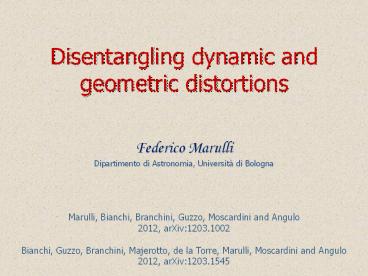Using VPERS to study the AGN galaxy environment PowerPoint PPT Presentation
Title: Using VPERS to study the AGN galaxy environment
1
Disentangling dynamic and geometric distortions
Federico Marulli Dipartimento di Astronomia,
Università di Bologna
- Marulli, Bianchi, Branchini, Guzzo, Moscardini
and Angulo - 2012, arXiv1203.1002
- Bianchi, Guzzo, Branchini, Majerotto, de la
Torre, Marulli, Moscardini and Angulo - 2012, arXiv1203.1545
2
Bologna cosmology/clustering group
- Carmelita Carbone
- Victor Vera (PhD)
- Fernanda Petracca (PhD)
- Carlo Giocoli
- Roberto Gilli
- Michele Moresco
- Lauro Moscardini
- Andrea Cimatti
- Federico Marulli
N-body with DE and neutrinos forecasts BAO
with new statistics DE and neutrino constraints
from ?(rp,p) HOD and HAM (Halo Abundance
Matching) AGN clustering P(k) clustering of
galaxy clusters galaxy/AGN evolution RSD
Alcock-Paczynski test clustering of
galaxies/AGN
3
Redshift space distortions
How to constract a 3D map
- Ra, Dec, Redshift ? comoving coordinates
- the real comoving distance is
- the observed galaxy redshift
- zc cosmological redshift due to the Hubble flow
- v component of the galaxy peculiar velocity
parallel to the line-of-sight
Geometric distortions
Observational distortions
Dynamic distortions
4
Dynamic and geometric distortions
The two-point correlation function
geometric distortions
geometric distortions
no distortions
dynamicgeometric distortions
dynamicgeometric distortions
dynamic distortions
5
Modelling the dynamical distortions
The dispersion model
non-linear model
linear model
model parameters
6
Statistical errors on the growth rate
dß/ß
density
bias
Bianchi et al. 2012
7
Effect of redshift errors on ß and s12
Dynamic distortions dz
Only dynamic distortions
dz ? small sistematic error on ß
Dynamic distortions dz
dß 5 for all dz
8
Effect of geometric distortions
Error on the bias
Error on ß
Spurious scale dependence in b(r)
Error on ?(s)/?(r)
GD ? dß is negligible
9
The Alcock-Paczynski test
- Steps of the method
- Choose a cosmological model to convert redshifts
into comoving coordinates - Measure ?
- Model only the dynamical distortions
- Go back to 1. using a different test cosmology
10
next future
- 10 N-body simulations with massive neutrinos
(L2 Gpc/h) - (1e6 CPU hours at CINECA)
- for
- all-sky mock galaxy catalogues via HOD and
box-stacking - all-sky shear maps via box-stacking and
ray-tracing - all-sky CMB weak-lensing maps
- end-to-end simulations for BAO and RSD
statistics - reference skies for future galaxy/shear/CMB-lensi
ng probes - ISW/Rees-Sciama implementation/analysis
- PI Carmelita Carbone
11
Conclusions
- systematic error on ß of up to 10, for small
bias objects - small systematic errors for haloes with more
than 1e13 Msun - scaling formula for the relative error on ß as a
function of survey parameters - the impact of redshift errors on RSD is similar
to that of small-scale velocity dispersion - large redshift errors (sv gt1000km/s) introduce a
systematic error on ß, that can be accounted for
by modelling f(v) with a gaussian form - the impact of GD is negligible on the estimate
of ß - GD introduce a spurious scale dependence in the
bias - AP test ? joint constraints on ß and OM
12
Mock halo catalogues
- BASICC simulation by Raul Angulo
- GADGET-2 code
- 14483 DM particles with mass 5.49e10 Msun/h
- periodic box of 1340 Mpc/h on a side
- ?CDM concordance cosmological framework
- (Om0.25, Ob0.045, O?0.75, h0.73, n1,
s80.9) - DM haloes FOF Mgt1e12 Msun/h
- Z1
13
Systematic errors on the growth rate
10
14
Errors on ß on different mass ranges
- Small masses Mlt5e12 Msun/h
- ? systematic error on ß 10
- Intermediate masses 5e12ltMlt2e13 Msun/h
- ? systematic error is small
- ? the linear model works accurately
- Large masses Mgt2e13 Msun/h
- ? large random errors
15
Statistical errors vs Volume
16
Effect of redshift errors on ß and s12
17
Effect of geometric distortions
1D correlation function
deprojected correlation
18
Effect of redshift errors on 1D ?

